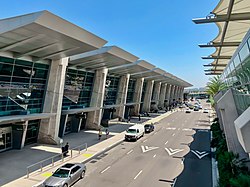Our website is made possible by displaying online advertisements to our visitors.
Please consider supporting us by disabling your ad blocker.
San Diego International Airport
San Diego International Airport | |||||||||||
|---|---|---|---|---|---|---|---|---|---|---|---|
 | |||||||||||
 SAN Terminal 2 in 2018 | |||||||||||
| Summary | |||||||||||
| Airport type | Public | ||||||||||
| Owner/Operator | San Diego County Regional Airport Authority | ||||||||||
| Serves | San Diego–Tijuana | ||||||||||
| Location | San Diego, California, U.S. | ||||||||||
| Opened | August 16, 1928 | ||||||||||
| Hub for | Alaska Airlines | ||||||||||
| Elevation AMSL | 17 ft / 5 m | ||||||||||
| Coordinates | 32°44′01″N 117°11′23″W / 32.73361°N 117.18972°W | ||||||||||
| Website | san.org | ||||||||||
| Maps | |||||||||||
![FAA airport diagram as of June 2019[update]](http://upload.wikimedia.org/wikipedia/commons/thumb/e/e0/KSAN_-_FAA_Airport_Diagram.svg/220px-KSAN_-_FAA_Airport_Diagram.svg.png) FAA airport diagram as of June 2019[update] | |||||||||||
 | |||||||||||
| Runways | |||||||||||
| |||||||||||
| Statistics (2023) | |||||||||||
| |||||||||||
San Diego International Airport (IATA: SAN, ICAO: KSAN, FAA LID: SAN) is the primary international airport serving San Diego and its surrounding metropolitan area, in the U.S. state of California. The airport is located three miles (4.8 km; 2.6 nmi) northwest of downtown San Diego. It covers 663 acres (268 ha) of land and is the third busiest airport in California in terms of passenger traffic.[6][7] It is the busiest single-runway airport in the United States.[8]
The airport is owned and operated by the San Diego County Regional Airport Authority.[6][9] It operates in controlled airspace served by Southern California TRACON.[10] The airport's landing approach is well known for its close proximity to the skyscrapers of downtown San Diego,[11] and can sometimes prove difficult to pilots due to the relatively short usable landing area, steep descent angle over the crest of Bankers Hill, and shifting wind currents just before landing.[12][13]
- ^ "Airport History". San Diego County Airport Authority. Archived from the original on October 4, 2017. Retrieved October 4, 2017.
- ^ "Alaska Airlines is in a Newark State of Mind". Splash.alaskasworld.com. Archived from the original on July 24, 2016. Retrieved December 2, 2016.
- ^ Hirsh, Lou (January 25, 2016). "San Diego International Airport Tops 20 Million Passengers for 2015". San Diego Business Journal. Archived from the original on January 27, 2016. Retrieved January 26, 2016.
- ^ "Air Traffic Reports". San Diego County Regional Airport Authority. 2017. Archived from the original on March 2, 2019. Retrieved February 10, 2023.
- ^ "San Diego International Airport Routes". Routes — Aviation Week Network. Retrieved May 25, 2024.
- ^ a b FAA Airport Form 5010 for SAN PDF. US Federal Aviation Administration. Effective November 28, 2024.
- ^ "SAN airport data at skyvector.com". skyvector.com. Retrieved August 27, 2022.
- ^ Candelieri (August 30, 2023). "San Diego International Airport is busiest single-runway airport in US". FOX 5 San Diego. Retrieved May 11, 2024.
- ^ "About the Airport Authority". San Diego County Regional Airport Authority. Archived from the original on September 23, 2006.
- ^ "Southern California TRACON (SCT)". US Federal Aviation Administration. Archived from the original on May 29, 2017. Retrieved May 29, 2017.
Southern California TRACON (SCT) serves most airports in Southern California and guides about 2.2 million planes over roughly 9,000 square miles in a year, making our facility one of the busiest in the world.
- ^ Lori Weisberg (August 3, 2011). "How safe is San Diego airport?". Archived from the original on June 22, 2019. Retrieved June 21, 2019.
Anyone who's ever glanced skyward as a jetliner is making its final approach into Lindbergh Field would swear that it could easily scrape one of the high-rises in its path. As scary as the impending landing seems, San Diego International Airport is in fact the seventh safest airfield in the U.S., according to Travel + Leisure magazine.
- ^ Sean Breslin (March 21, 2017). "The 10 Most Challenging U.S. Airports, According to Honeywell". Archived from the original on June 22, 2019. Retrieved June 21, 2019.
Weather in San Diego is known for being ideal much of the year, but there are other factors that make arrivals and departures to this airport among the toughest in the nation. According to Honeywell, pilots must make a steep approach into the airport, and strong tailwinds can also be present.
- ^ RALPH FRAMMOLINO and GEORGE RAMOS (April 26, 1988). "S.D. Airport Rated 5th on Danger List: Pilots Call LAX Most Dangerous in Nation". Los Angeles Times. Archived from the original on June 22, 2019. Retrieved June 21, 2019.
The mountains to the east force pilots to make a steep landing on a relatively short runway, said Dick Russell, a United Airlines pilot and area safety coordinator for the Air Line Pilots Assn. (ALPA) chapter in Los Angeles. The runway measures 9,400 feet, but angling in over the man-made and natural obstacles effectively shortens that by 1,800 feet, Russell said.
Previous Page Next Page
San Diego Internasionale Lughawe AF مطار سان دييغو الدولي Arabic مطار سان دييجو الدولى ARZ San Diego International Airport CEB Mezinárodní letiště San Diego Czech San Diego International Airport German Flughaveno San-Diego EO Aeropuerto Internacional de San Diego Spanish San Diego rahvusvaheline lennujaam ET San Diegoko Nazioarteko Aireportua EU


